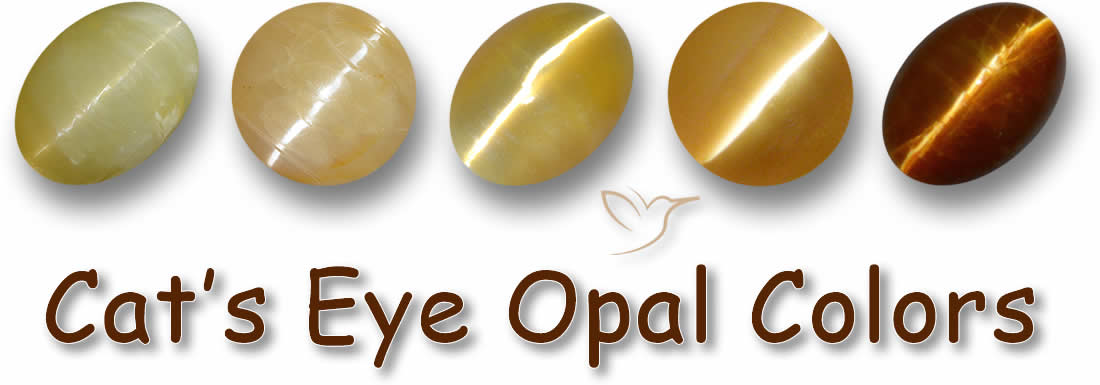Cat's Eye Opal Information

Introduction to Cat's Eye Opal
Cat's Eye Opal stands out as a fascinating gemstone due to its distinctive optical effect called chatoyancy. This creates a glowing band of light that shifts across the stone's surface, much like a cat's slit eye. You might find yourself staring at it, watching that line dance with every turn.
These gemstones are quite rare and not commonly available. When you do come across them, Cat's Eye Opals can impress with a sharp bar of light that contrasts beautifully against their warm, earthy background tones.
How Cat's Eye Opals Form
Opals develop over millions of years as silica gel hardens in rock cracks and crevices. Unlike most gemstones with a crystal structure, opals consist of numerous tiny spheres. In some cases, these spheres cause light to diffract, producing the famous 'play-of-color' that makes opals so prized.
Some opals lack this play-of-color and appear in solid hues, often soft pastels like pink or blue from Peru, or bold reds and oranges in Fire Opals.
The cat's eye effect comes from fibers or needles inside the stone that reflect light. When cut and polished expertly, it mimics a cat's eye perfectly - hence the name.
For more in-depth details on opal varieties and properties, explore our comprehensive opal gemstone guide.
Shape and Cut
Cat's Eye Opals are typically shaped into rounds or ovals with a domed top and flat base. This cut highlights the chatoyancy while enhancing the stone's natural color. It's all about making that eye pop, right?
Color
These opals often feature golden honey shades, but they can also appear in yellow, cream, or earthy browns.

Color matters in evaluating any gem, but for cat's eyes, the key is the eye's strength and clarity. Cat's Eye Opals are celebrated for that crisp, bright line of light shimmering just under the surface.
Sources
Cat's Eye Opals are especially scarce, with Madagascar and Tanzania as main suppliers, though Brazil might offer some too. Places like Idaho in the US and Western Australia have yielded colorful specimens with play-of-color, but often with a fainter eye.
Spiritual Meaning
Cat's Eye Opal is thought to hold strong metaphysical qualities that boost intuition, insight, and spiritual awareness. It serves as a protective charm, guarding against negative energies and fostering clear thinking. Linked to the Third Eye chakra, it supports inner vision and strengthens ties to the spiritual world. This stone is said to promote balance across mind, body, and spirit, aiding self-discovery and growth. People attracted to it might embark on paths of enlightenment, influenced by its mystical vibes.
Disclaimer: The spiritual meanings and properties attributed to gemstones like Cat's Eye Opal are rooted in folklore, cultural traditions, and personal beliefs. They are not supported by scientific evidence and should not replace professional medical or psychological advice.
By the way, Cat's Eye Opals are the birthstone for October and make a traditional gift for the 14th wedding anniversary.
Care and Maintenance
With a Mohs hardness of 5.5 to 6, opals are relatively soft but can handle minor impacts. Still, it's wise to avoid knocks. We suggest removing jewelry before tasks like cleaning, sports, or gardening.
Store opals separately from harder gems to prevent scratches or damage. Use individual cloth bags or boxes for added safety.
For additional expert advice on maintaining your opal jewelry, visit our guide to caring for opals.
Frequently Asked Questions
What is Cat's Eye Opal?
Cat's Eye Opal is a gemstone known for its chatoyancy, which creates a moving band of light resembling a cat's eye.
How does the cat's eye effect occur?
It results from fibers or needles within the stone that reflect light, enhanced by proper cutting and polishing.
What colors are available for Cat's Eye Opals?
They typically come in golden honey, yellow, cream, or earthy brown tones.
Where are Cat's Eye Opals sourced from?
Main sources include Madagascar and Tanzania, with potential from Brazil, Idaho in the US, and Western Australia.
How should I care for my Cat's Eye Opal?
Avoid impacts, remove before physical activities, and store separately from harder gems in protective bags or boxes.
What is the spiritual significance of Cat's Eye Opal?
It is believed to enhance intuition and provide protection, but these claims are based on beliefs, not science.

